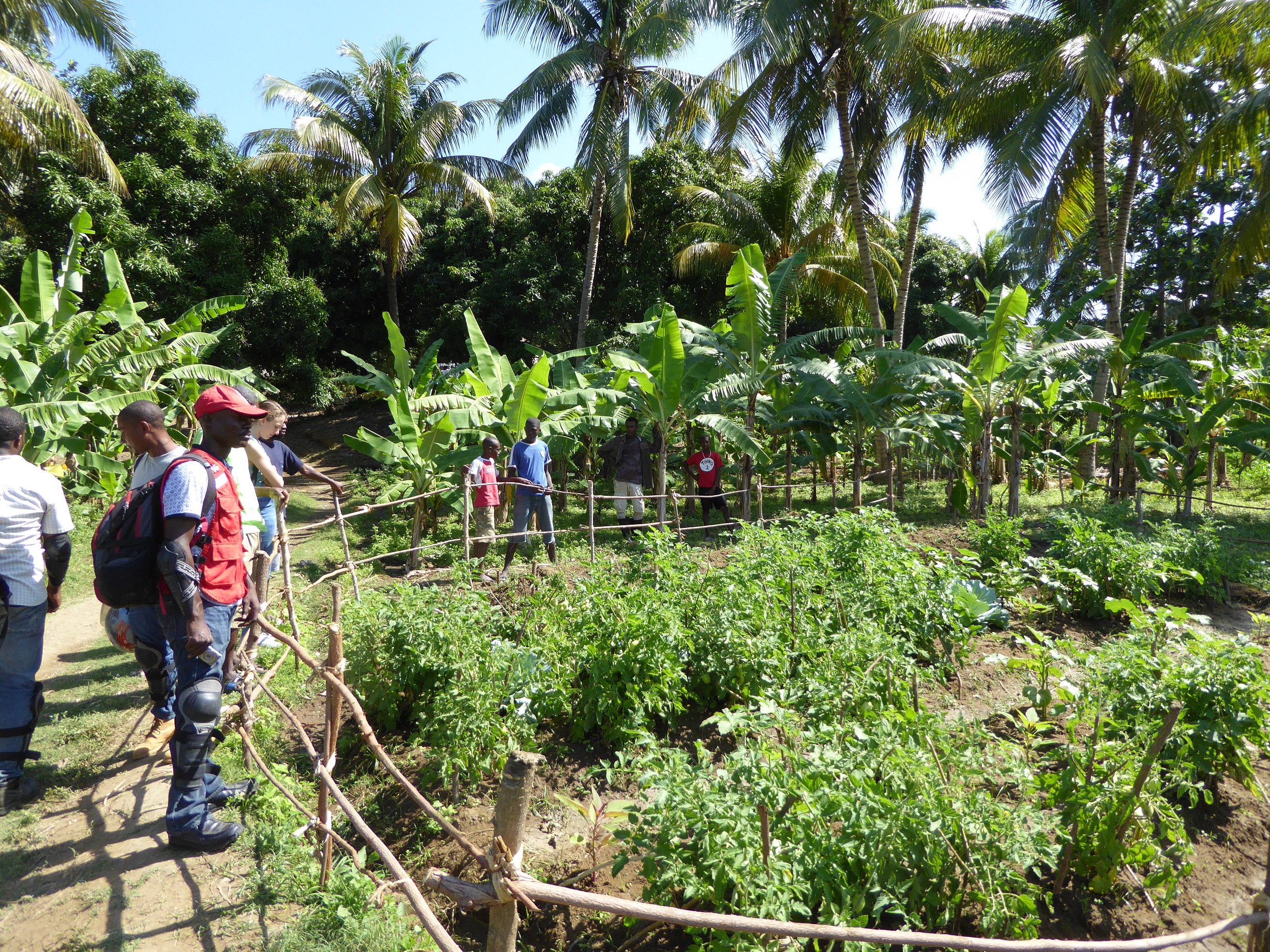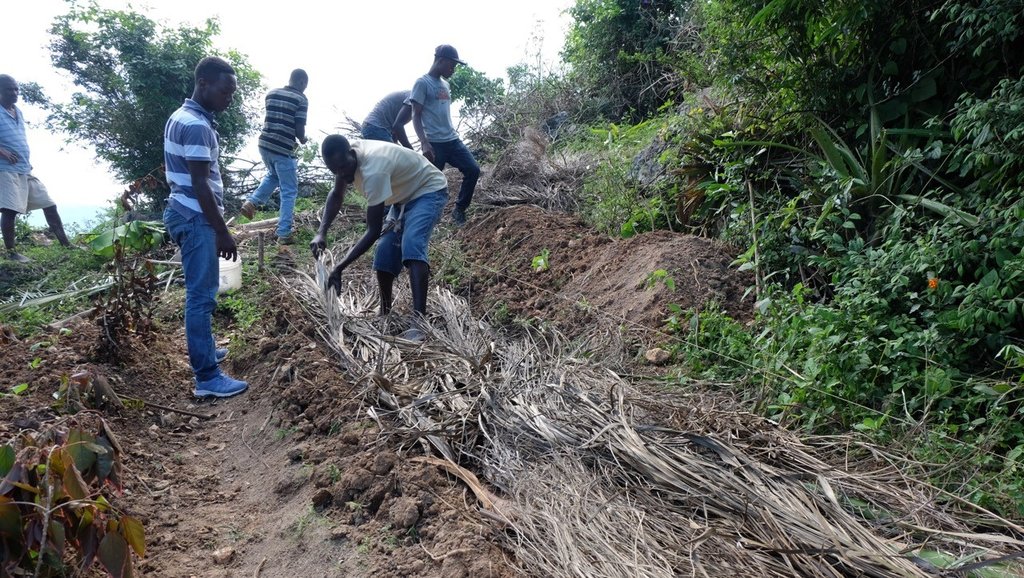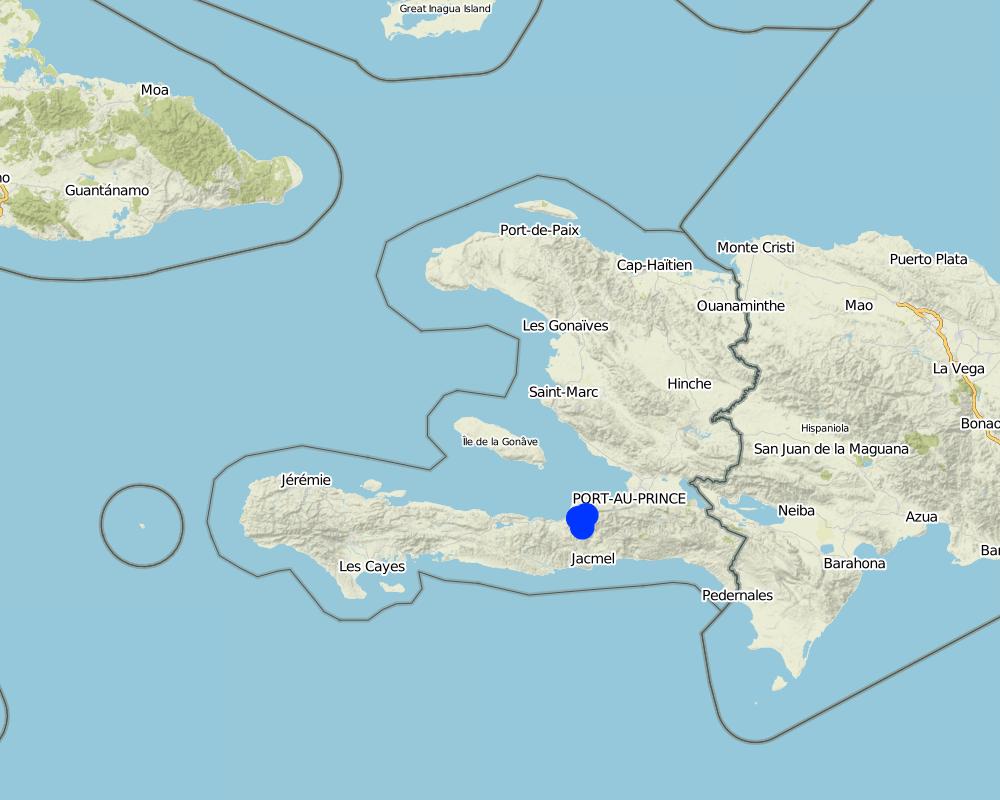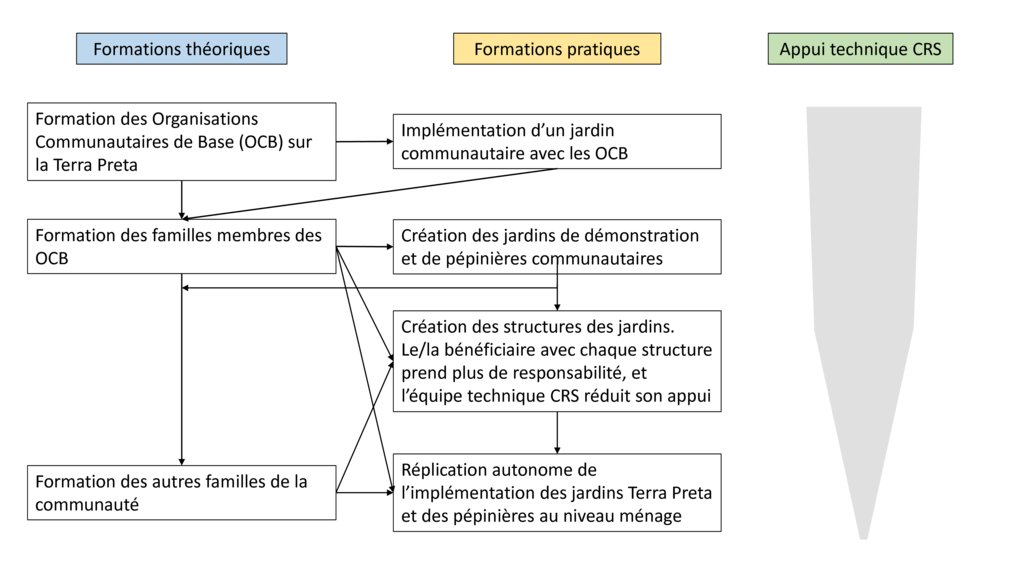Approach at household level for Terra Preta home gardens [Haiti]
- Creation:
- Update:
- Compiler: Helen Gambon
- Editor: Anton Jöhr
- Reviewers: Alexandra Gavilano, Hanspeter Liniger, Nicole Harari
approaches_1953 - Haiti
View sections
Expand all Collapse all1. General information
1.2 Contact details of resource persons and institutions involved in the assessment and documentation of the Approach
Key resource person(s)
SLM specialist:
Jean Evale Guetchine
guetchine04.jean@gmail.com
Swiss/Haitian Red Cross
Carrefour Colas, Léogâne
Haiti
SLM specialist:
Dessin Jean-Carls
jcarls.dessin@redcross.ch
Swiss/Haitian Red Cross
Carrefour Colas, Léogâne
Haiti
SLM specialist:
Name of project which facilitated the documentation/ evaluation of the Approach (if relevant)
Book project: where people and their land are safer - A Compendium of Good Practices in Disaster Risk Reduction (DRR) (where people and their land are safer)Name of the institution(s) which facilitated the documentation/ evaluation of the Approach (if relevant)
Swiss Red Cross (Swiss Red Cross) - Switzerland1.3 Conditions regarding the use of data documented through WOCAT
When were the data compiled (in the field)?
14/03/2017
The compiler and key resource person(s) accept the conditions regarding the use of data documented through WOCAT:
Yes
1.4 Reference(s) to Questionnaire(s) on SLM Technologies
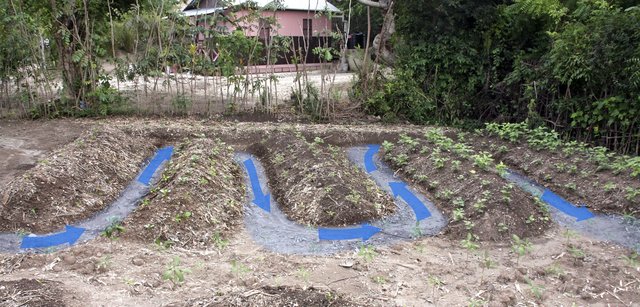
Terra Preta raised garden beds [Haiti]
Terra Preta raised garden beds are a combination of techniques from permaculture and the production of Terra Preta, an anthrosol. These garden beds, which were created with local resources, are highly fertile and enable the production of much higher yields than traditional techniques, while diminishing soil erosion.
- Compiler: Karl Harald Bier
2. Description of the SLM Approach
2.1 Short description of the Approach
The approach of the Terra Preta home gardens at household level, with demonstration gardens created with members of grass-roots community organizations (GCO), facilitates the extension of the Terra Preta technology among the vulnerable population in the rural zones of the municipality of Léogâne, Haiti.
2.2 Detailed description of the Approach
Detailed description of the Approach:
One of the key problems of the Haitian rural population is related to the intensive use of the soil, and its degradation due to the strong demographic pressure on the mountainous zones. This intensifies the effects of natural hazards, especially those linked to hydrological and meteorological events. The severe degradation decreases the agricultural production. Because agriculture is the major source of income of the rural population of the community of Léogâne, chronic malnutrition is one of the important health problems. The Swiss Red Cross promotes the Terra Preta at household level to address several factors of vulnerability. Terra Preta is an innovative technology to create and fertilise soils through the recovery of organic waste. The approach followed for the dissemination of the technology functions as follows:
As a first step, the active and interested members of grass-roots community organizations (GCO) receive theoretical training (one day) which covers the following aspects: definition and origin of the Terra Preta technology, introduction to the different structures created (garden beds and garden surfaces), the materials used, the implementation procedures, practical experience in Haiti and the advantages of the technology.
Next, a first home garden is implemented with the cooperative of trained farmers. Together with the members of the grass-roots community organization, who show interest after this first cycle of training, private gardens are implemented at the household level. The establishment of the first structure (which is a mound and/or a surface) for a family is realised by the project team, showing the necessary steps to the beneficiary, who contributes with labor. After some time, the second structure is established in a similar way. For the establishment of the third structure, the beneficiary coordinates the work, and the team provides support or corrections if necessary. Generally a farmer is ready to do the replication himself from the fourth structure onwards.
These exemplary home gardens of the members of the grass-roots community organization serve as demonstration plots for other families in the community. If a family shows interest to implement a Terra Preta home garden, the project team provides the technical support as described.
Seed production: the first seedlings are donated by the project to the families. The families are then trained in the production of seed and the creation of nurseries for replanting vegetables. In this way, the project aims to contribute to the food self-sufficiency of the families.
Gender: generally the men are in charge of the establishment of the home gardens in Haiti. It is recommended to involve women in the maintenance of the gardens. The experience shows that women are often more engaged then men, and it is more probable that the vegetables produced are used to feed the family instead of being sold.
2.3 Photos of the Approach
2.5 Country/ region/ locations where the Approach has been applied
Country:
Haiti
Region/ State/ Province:
Municipality of Léogâne
Further specification of location:
Cormier, Fond de Boudin, Palmiste-à-Vin, Fond' Oie, Petit Harpon
Map
×2.6 Dates of initiation and termination of the Approach
Indicate year of initiation:
2014
2.7 Type of Approach
- project/ programme based
2.8 Main aims/ objectives of the Approach
The creation and fertilisation of soils, through the recovery of organic waste and residues, contribute to the resilience of families, an increase of food self-sufficiency and a reduction of malnutrition.
2.9 Conditions enabling or hindering implementation of the Technology/ Technologies applied under the Approach
social/ cultural/ religious norms and values
- hindering
The people in the region are not used to practice vegetable growing.
institutional setting
- enabling
The approach to strengthen the capacities of grass-roots community organizations fosters the implemetation of Terra Preta home gardens.
collaboration/ coordination of actors
- enabling
Strict planning and monitoring are essential for the collaboration and coordination between the actors. The trust between the beneficiaries (GCO and individual households) and the technical team of the Swiss/Haitian Red Cross is the foundation for the sustainable implementation of Terra Preta home gardens.
knowledge about SLM, access to technical support
- enabling
Terra Preta home gardens are an innovative technology which was not known before in the community.
3. Participation and roles of stakeholders involved
3.1 Stakeholders involved in the Approach and their roles
- local land users/ local communities
Households in the intervention zone of the project 'Risk and disaster management' of the Swiss Red Cross.
Implementation, replication and maintenance of their home gardens.
- community-based organizations
grass-roots community organization (GCO)
Implementation of demonstration gardens to motivate other families.
- NGO
Swiss/Haitian Red Cross
Technical and material support (seed or seedlings), monitoring
3.2 Involvement of local land users/ local communities in the different phases of the Approach
| Involvement of local land users/ local communities | Specify who was involved and describe activities | |
|---|---|---|
| planning | passive | |
| implementation | interactive | |
| monitoring/ evaluation | interactive |
3.3 Flow chart (if available)
Description:
Process of knowledge transfer on the Terra Preta home gardens by projects of the Swiss Red Cross
Author:
Helen Gambon, Swiss Red Cross
3.4 Decision-making on the selection of SLM Technology/ Technologies
Specify who decided on the selection of the Technology/ Technologies to be implemented:
- SLM specialists alone
Explain:
The innovative Terra Preta technology was introduced in a pilot to see whether it could meet the needs of the beneficiaries.
Specify on what basis decisions were made:
- evaluation of well-documented SLM knowledge (evidence-based decision-making)
4. Technical support, capacity building, and knowledge management
4.1 Capacity building/ training
Was training provided to land users/ other stakeholders?
Yes
Specify who was trained:
- land users
Form of training:
- on-the-job
- demonstration areas
Subjects covered:
Definition and origin of Terra Preta, the different structures, the materials used, the procedures for the establishment, the practical experiences in Haiti, the advantages of the technology.
Comments:
Theoretical and practical training.
4.2 Advisory service
Do land users have access to an advisory service?
Yes
Specify whether advisory service is provided:
- on land users' fields
Describe/ comments:
The technical staff of the Swiss/Haitian Red Cross provides continuous technical assistance to the beneficiaries (Grass-roots Community Organization and individual households).
4.3 Institution strengthening (organizational development)
Have institutions been established or strengthened through the Approach?
- yes, a little
Specify the level(s) at which institutions have been strengthened or established:
- local
Describe institution, roles and responsibilities, members, etc.
The role of the grass-roots community organizations (GCO) is to motivate the community for development.
Specify type of support:
- capacity building/ training
4.4 Monitoring and evaluation
Is monitoring and evaluation part of the Approach?
Yes
Comments:
Monitoring and evaluation are an integral part of the projects of the Swiss/Haitian Red Cross.
If yes, is this documentation intended to be used for monitoring and evaluation?
No
4.5 Research
Was research part of the Approach?
Yes
Specify topics:
- ecology
Give further details and indicate who did the research:
Collaboration with students from local universities (theses).
5. Financing and external material support
5.1 Annual budget for the SLM component of the Approach
If precise annual budget is not known, indicate range:
- 10,000-100,000
Comments (e.g. main sources of funding/ major donors):
Includes inputs like seed and seedlings as well as training. Main source of funding: the Swiss Red Cross.
5.2 Financial/ material support provided to land users
Did land users receive financial/ material support for implementing the Technology/ Technologies?
No
5.3 Subsidies for specific inputs (including labour)
- agricultural
| Specify which inputs were subsidised | To which extent | Specify subsidies |
|---|---|---|
| seeds | fully financed | |
| seedlings | fully financed | |
If labour by land users was a substantial input, was it:
- voluntary
5.4 Credit
Was credit provided under the Approach for SLM activities?
No
5.5 Other incentives or instruments
Were other incentives or instruments used to promote implementation of SLM Technologies?
No
6. Impact analysis and concluding statements
6.1 Impacts of the Approach
Did the Approach empower local land users, improve stakeholder participation?
- No
- Yes, little
- Yes, moderately
- Yes, greatly
Did the Approach enable evidence-based decision-making?
- No
- Yes, little
- Yes, moderately
- Yes, greatly
The demonstration plots have helped to motivate households to implement a vegetable garden.
Did the Approach help land users to implement and maintain SLM Technologies?
- No
- Yes, little
- Yes, moderately
- Yes, greatly
The approach has introduced an innovative technology for sustainable land management, which serves to create and fertilise soils and to retain water in the soil.
Did the Approach mobilize/ improve access to financial resources for SLM implementation?
- No
- Yes, little
- Yes, moderately
- Yes, greatly
The access to financial resources is not an objective of the approach.
Did the Approach improve knowledge and capacities of land users to implement SLM?
- No
- Yes, little
- Yes, moderately
- Yes, greatly
30-40% of the beneficiaries are in a position to replicate the technology by themselves.
Did the Approach improve knowledge and capacities of other stakeholders?
- No
- Yes, little
- Yes, moderately
- Yes, greatly
The Grass-roots Community Organizations replicate the Terra Preta home gardens and support families in the establishment of the gardens.
Did the Approach build/ strengthen institutions, collaboration between stakeholders?
- No
- Yes, little
- Yes, moderately
- Yes, greatly
Did the Approach mitigate conflicts?
- No
- Yes, little
- Yes, moderately
- Yes, greatly
Did the Approach empower socially and economically disadvantaged groups?
- No
- Yes, little
- Yes, moderately
- Yes, greatly
The objective of the approach is to empower the most vulnerable people first.
Did the Approach improve gender equality and empower women and girls?
- No
- Yes, little
- Yes, moderately
- Yes, greatly
Often women look after the gardens, which gives them the possibility to contribute to the needs of the families.
Did the Approach encourage young people/ the next generation of land users to engage in SLM?
- No
- Yes, little
- Yes, moderately
- Yes, greatly
The education of students in agronomy is part of the approach.
Did the Approach lead to improved food security/ improved nutrition?
- No
- Yes, little
- Yes, moderately
- Yes, greatly
The vegetables grown in the gardens contribute much to food security and diversification of nutrition.
Did the Approach improve access to markets?
- No
- Yes, little
- Yes, moderately
- Yes, greatly
The approach does not have as main goal to improve the access to markets, but some beneficiaries have been able to profit from it by selling surplus products. The gardens offer a possibility to generate harvests in a short time, which contributes for example to a quick rehabilitation after hurricanes. Because the gardens function as water reservoirs, the vegetative period is extended with several weeks, and the gardens can resist to dry periods.
Les jardins offrent une possibilité de générer des récoltes en courte durée. (vite réhabilitation après ouragans). En plus, les jardins peuvent résister aux périodes sèches.
6.2 Main motivation of land users to implement SLM
- increased production
The soil becomes more fertile and productive, and therefore capable to produce vegetables.
- reduced land degradation
Haitian soils are very degraded, and agricultural production has become difficult. The Terra Preta home gardens offer the possibility to create and fertilise the soils.
6.3 Sustainability of Approach activities
Can the land users sustain what has been implemented through the Approach (without external support)?
- yes
If yes, describe how:
A number of beneficiaries is already able to replicate the technology in an autonomous way. During the continuation of the project, the Swiss/Haitian Red Cross aims to augment the number of households capable of replicating the technology.
6.4 Strengths/ advantages of the Approach
| Strengths/ advantages/ opportunities in the land user’s view |
|---|
| There is a high confidence in the technical staff, because of its continuous presence in the field. |
| The approach strengthens the capacity of the households to become self-sufficient and to improve the food security. |
| Strengths/ advantages/ opportunities in the compiler’s or other key resource person’s view |
|---|
| The approach promotes the extension of the technology. |
| The demonstration plots serve as a driver of motivation for certain beneficiaries. |
6.5 Weaknesses/ disadvantages of the Approach and ways of overcoming them
| Weaknesses/ disadvantages/ risks in the land user’s view | How can they be overcome? |
|---|---|
| The availability of materials for the implementation of the Terra Preta gardens is not always guaranteed, and the collection (of wood) takes time. | Awareness raising and motivation by the technical staff. The planning of activities must be done jointly by the technical staff and the beneficiaries. |
| Weaknesses/ disadvantages/ risks in the compiler’s or other key resource person’s view | How can they be overcome? |
|---|---|
| The availability of vegetable seeds is not always guaranteed in the local market. | The beneficiaries learn how to produce their own seeds from their vegetables. |
| Recurrent droughts can hamper the development of the gardens. | In the dry zones, the gardens are preferably implemented close to a water source. In the established gardens, mulching can be done. |
7. References and links
7.1 Methods/ sources of information
- interviews with SLM specialists/ experts
2
Links and modules
Expand all Collapse allLinks

Terra Preta raised garden beds [Haiti]
Terra Preta raised garden beds are a combination of techniques from permaculture and the production of Terra Preta, an anthrosol. These garden beds, which were created with local resources, are highly fertile and enable the production of much higher yields than traditional techniques, while diminishing soil erosion.
- Compiler: Karl Harald Bier
Modules
No modules


